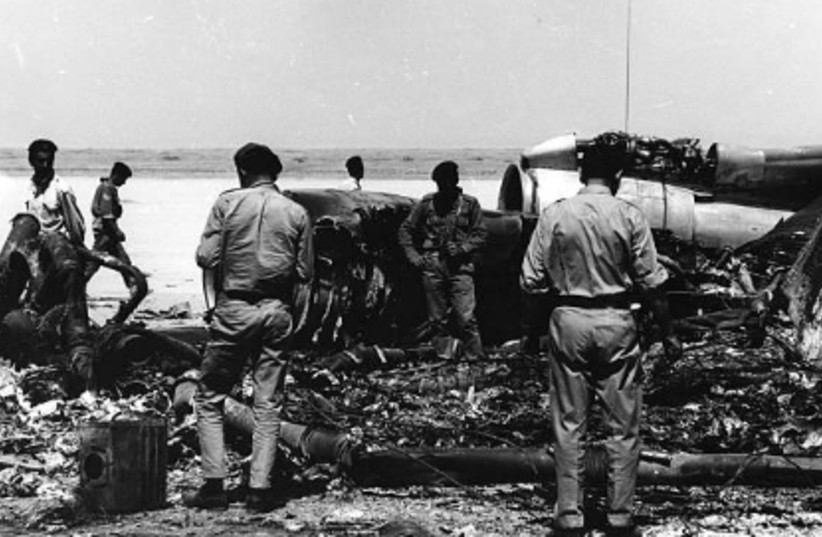Martha Hodes wanted to know what it was like to be 12 years old, traveling with a sister on an international flight that’s hijacked.
Hodes was that girl, but her preoccupation during six sweltering days and frigid nights in a parked airliner, the passage of decades, and her deliberate repression had made her memories scanty and disconnected. She had trouble relating to having been there.
“We ended up as hostages in the Jordan desert,” says Hodes, an author and history professor at New York University. She and sister Catherine, almost 14, were traveling from their mother in Tel Aviv to their father in New York. They and passengers aboard two other hijacked airliners were held against a demand for release of imprisoned terrorists.
“None of us hostages yet knew that we were part of the biggest hijacking operation the world had ever seen.”
“None of us hostages yet knew that we were part of the biggest hijacking operation the world had ever seen.”
Martha Hodes
The biggest hijacking operation in history
My Hijacking: A Personal History of Forgetting and Remembering is Hodes’s account as she remembered, researched, and reconstructed it. She wanted to understand why she’d tried to act as if it was of no importance and how its repression affected her life beyond a continuing unease about flying.
Much more interesting than I’d expected, My Hijacking is well and clearly written, though jumping back and forth in time. Throughout are quotations from The Little Prince, Hodes’s favorite book that summer.
She’s not unsympathetic to her captors’ sentiments, with sad tales of fleeing homes and businesses (Jews from Arab nations have an equal number) and avoids calling them terrorists—a fitting term – but more neutrally “hijackers” or, inaccurately, “commandos.” No. Commandos are small military units for quick raids, sometimes to free hostages.
The deadly 9/11 hijackings prompted her to consider her experience. “That’s when I realized how little I remembered,” she says. “I wanted to connect to the 12-year-old girl who buried as much as she could … I wanted to do more than excavate my own memories.”
The Popular Front for the Liberation of Palestine’s three-airliner hijacking on Sunday, September 6, 1970, was world-grabbing news. Commandeered were her TWA flight (after Frankfurt) and airliners from Swissair, Pan Am, and El Al – the last foiled when the pilot suddenly dropped altitude, toppling terrorist Leila Khaled to the floor, where passengers subdued her. A guard shot the other hijacker dead. The Pan Am plane was hijacked to Cairo and destroyed.
On September 9, a BOAC airliner was hijacked to the abandoned airstrip where TWA 741 and Swissair were parked, making about 400 hostages. On their aircraft, the sisters counted an elderly rabbi, seven infants, 15 toddlers, and a six-year-old girl, alone.
PFLP members pointed rifles at them but usually were polite, saying they would not be harmed. Some were taken forward for interrogation. Hijackers said their motive was to gain world attention for their cause. Mission accomplished. Luggage was opened, and anything suspected of coming from Israel was removed.
Hostages were fed varied amounts by the PFLP, then better by the Red Cross, which provided physicians augmenting a PFLP doctor.
But they sat sweating and unbathed amid increasing litter with a reeking, overflowed toilet, eventually eased when the flight engineer found and opened a drain valve.
Passengers suffered discomfort, dirt, odor, hunger, and thirst, but not physical abuse. The PFLP installed explosives, threatening to set them off unless nations met their demands.
At one point, the hijackers ordered everyone off the airplane and drove some of them away, leaving the rest, mostly Jews, in a circle surrounded by armed terrorists.
Catherine said she expected them all to be killed. But they were ordered back inside, wives frightened for missing husbands, and Sara Raab left with two children but not David, her oldest. He was one of 56 people unaccounted for when most of the hostages were released and flown out. Eventually, all would be freed, at the cost of exploded aircraft and released terrorists. Raab would write a 2007 book about the experience called Terror in Black September.
“After we came home, there was no debriefing by authorities,” Hodes says. “No teacher sent us to a school guidance counselor, and no one took us to a therapist. Our parents never told us what it was like for them,” heightening her feelings of the hijacking “as an experience best ignored.”
Her best friend “wanted to know everything, but I didn’t want to talk about it.”
Her parents, minimally observant Jews, were theatrical dancers, acclaimed mother Linda with Martha Graham and Israel’s Batsheva Dance Company, which attracted her to remain in Israel. The daughters lived with their father, Stuart, during the school year, and with their mother in summers.
Her parents’ reticence about their split made it “easiest to dismiss the uncomfortable emotions that none of us wanted to acknowledge anyway,” Hodes says. “By the time I boarded the flight home...I was adept at banishing uncomfortable feelings.”
How did the hostages pass all that time? They talked, played games, bickered, sang – with modifications such as “I’m living on a jet plane” – and slept, perhaps for a reason we discover late in the book that might have dimmed memory: The Red Cross physicians freely distributed tranquilizers. She doesn’t remember if she and Catherine took them.
For the book, she augmented her memory at the National Archives: newspaper accounts, TWA records, flight-crew reports and TV news footage. She interviewed other hostages and used British and Swiss archives. She discovered things she’d forgotten, things she’d not known, and photos showing her and Catherine.
But “all these years later,” she says,”I’m still unable to recapture a real memory of fear.” ■
Neal Gendler is a Minneapolis writer and editor.
My Hijacking: A personal history of forgetting and rememberingMartha HodesHarper, 367 pages, $32

